In the fight against acne or single pimples, the antiseptic and bactericidal drug chlorhexidine is very helpful. This affordable and effective remedy can be found in any pharmacy. Read our review about how to effectively use chlorhexidine for acne on the face and body.
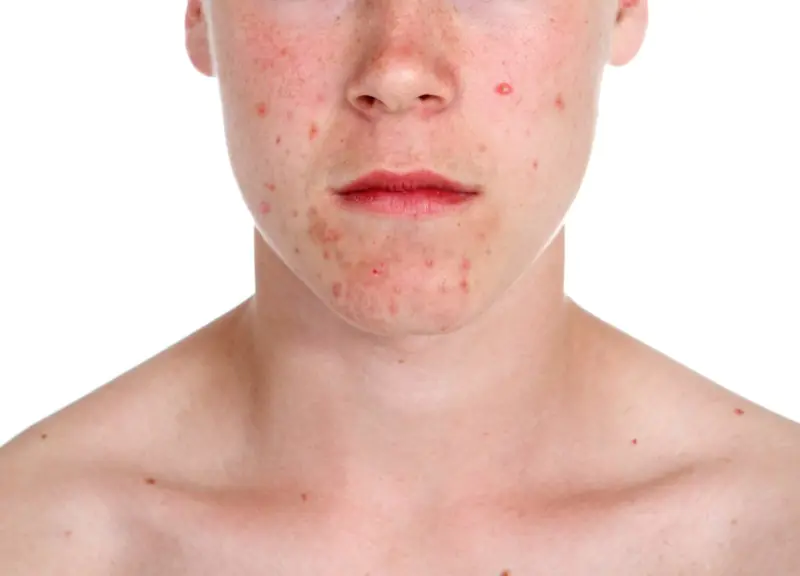
Description of the drug
The drug belongs to the class of antiseptics for external and local use. The drug destroys pathogenic microflora, which includes various types of microbes, viruses, bacteria and fungi. Such a wide spectrum of action allows you to effectively disinfect any surfaces with chlorhexidine. The antiseptic is able to penetrate into the deep layers of the skin and provide a duration of action of up to 2 days.
Chlorhexidine bigluconate is produced in the form of a solution of 0.01 - 20% in water or alcohol. The disinfectant is available in the form of a colorless liquid, bitter in taste and odorless. There are different forms of release:
- aqueous solution in the form of liquid in bottles;
- alcohol solution in the form of a spray;
- gel with the addition of lidocaine;
- vaginal suppositories;
- bactericidal patches.
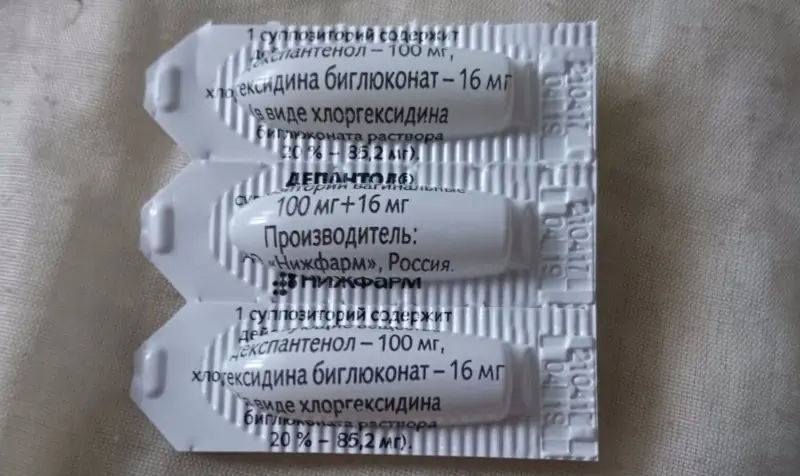
The popular antiseptic is widely used in surgical operations, in dermatology, as well as in the treatment of gynecological and dental diseases.
In the form of an alcohol and aqueous solution it is used for:
- treatment of wound and burn surfaces;
- disinfection of the skin surface before and after manipulations;
- disinfection of the hands of doctors and medical staff during manipulations;
- disinfection of the mouth, throat, dentures;
- treatment of inflammatory gynecological diseases;
- prevention of sexually transmitted diseases;
- surface treatment of medical equipment and devices;
- hygienic treatment of hands of catering and utility workers.
The principle of action of chlorhexidine against acne
The interaction of the active component of the drug with bacteria, fungi and protozoan microorganisms destabilizes and destroys their cell membranes. As a result, they die from damage to cell walls and loss of nutrients. The drug also reacts with protein substances in the epidermis and, after destroying microorganisms, helps remove their waste products from the skin.
Chlorhexidine bigluconate destroys most types of gram-positive and gram-negative bacteria that can provoke the appearance and spread of acne. Wiping the surface of the face or body with the preparation guarantees complete simultaneous disinfection and destruction of all pathogenic microflora. This property is successfully used against most pathogens of infectious processes such as pustular rashes, skin inflammation and acne.
Methods of application
To treat ulcers and rashes, use an aqueous solution of 0.01%, 0.02% and 0.05% or an alcohol solution of 0.5% in the form of a spray. General principle: if a large area of surface is required to be treated (the entire face, shoulders, back), then a relatively weak solution is taken, and a higher concentration of the drug is suitable for targeted use. Before applying an antiseptic to an inflamed surface, it is necessary to disinfect your hands. To do this, 5 - 10 ml of the drug is applied to the hands and thoroughly rubbed into the skin for 1 minute.
The medicine can be used to wipe the face either as an independent procedure or after instrumental cleansing of the face from acne.
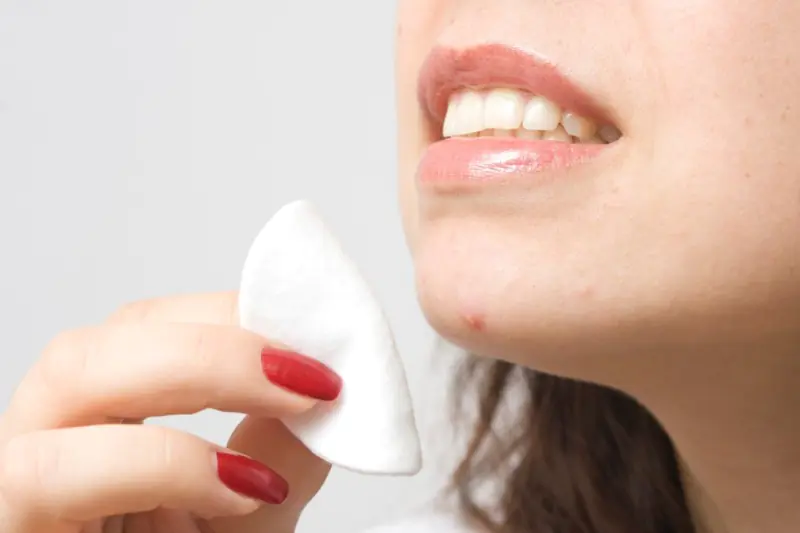
- The chlorhexidine treatment procedure does not require preliminary cleansing of the face. You can simply wash your face with clean water, but without soap or other cleansers.
- Moisten a cotton pad with a solution of 0.01 - 0.02% and gently wipe all areas affected by rashes or pimples.
- It is advisable to repeat this action 2 times a day, morning and evening. The duration of the course of procedures is prescribed by the doctor, on average about 14 days.
- A combination of such treatment with subsequent application of an antibacterial agent, for example Levomekol ointment, is effective.
- If the skin itself is dry and prone to irritation, you can apply a moisturizer half an hour after wiping.
If you need to treat the wound after opening the pimple and removing the purulent contents from it, prepare several tampons soaked in an antiseptic. Having opened the head of the pimple with a medical needle, remove the pus from it using sterile cotton pads, lightly pressing on the surface of the skin on both sides. The pus from the pimple is washed off using a swab soaked in chlorhexidine, and then another, clean swab with an antiseptic is applied to the wound and held for 1 to 3 minutes.
The combination of chlorhexidine with ethyl alcohol significantly enhances the effect of the active substance, so this method of treating acne is considered very effective. Irrigation of acne with 5% alcohol spray is recommended to be done pointwise. There is a certain risk of drying and irritating delicate skin. Large areas of the face and body can be treated in this way only in certain cases, for example, with increased oily skin.
Directions for use: Spray the spray onto cleansed skin in areas of inflammation and leave until completely dry. After 30 minutes, if necessary, apply antibacterial ointment or moisturizer. Repeat the treatment 2 times a day for the treatment period prescribed by the dermatologist (usually 10 - 20 days).
Applications or lotions differ from rubbing by the time of exposure of the medicinal product. Sequence of the procedure:
- Gently cleanse the skin by washing with water without using soap or cosmetics.
- Apply an antiseptic solution to a sterile fabric bandage or cotton pad so that the base is completely saturated, but without excess.
- Apply the application to the rash area and leave for 1 to 10 minutes. The duration of exposure to the drug is usually prescribed by the doctor.
- After removing the application, wait for the skin to dry; after 30 minutes, apply a bactericidal cream or moisturizer.
- If you have increased irritability and dry skin, you can rinse your face immediately after application with clean water to remove any remaining product.
- Repeat as prescribed by a specialist, usually once a day for 1 - 2 weeks.
As part of disinfecting and drying masks, the use of this antiseptic is suitable for people with oily skin prone to rashes and pimples. They can significantly improve the condition of the skin, eliminate excess fat and minor inflammation. The use of such products for dry skin prone to peeling and irritation is not recommended!
Here are popular recipes for medicinal masks:
- Cosmetic clay mask with chlorhexidine. Mix 1 tablespoon of dry powder of black, white or blue clay with 1 tablespoon of 0.01% chlorhexidine solution. Apply to the problem area and leave until completely dry. Then rinse off the composition and apply a moisturizer. Can be repeated 2 times a week.
- Mask made from baby powder and chlorhexidine. Mix talc-based baby powder with chlorhexidine 0.01% in equal parts. Apply with a sponge to areas with inflammation and leave until completely dry. Then carefully remove the mask. A light white coating should remain on the skin after the mask. You don’t have to wash it off, but leave it on for several hours, possibly overnight. It is advisable to repeat this procedure no more than once a week so that the skin has time to rest and recover.
Contraindications and limitations of chlorhexidine
This highly active remedy has a number of contraindications, but in relation to the treatment of acne and skin rashes there are few of them. These are hypersensitivity, an individual reaction of the body, skin forms of allergies and some skin diseases (dermatoses, dermatitis, eczema).
It is not advisable to wash your face with hard water before using chlorhexidine, as it can weaken the effect of the antiseptic.
In addition, the drug is incompatible:
- with soap and alkaline detergents;
- iodine, hydrogen peroxide;
- phosphates, citrates, borates;
- carbonates, chlorides, sulfates.
Chlorhexidine is not used in ophthalmology; it is irritating to the delicate mucous membrane. If the medicine gets into your eyes, rinse them with plenty of running water. This drug is also not used for the treatment and disinfection of the ear canals, although it will not cause much harm if it gets into the ear.
In the summer, antiseptics should be used with caution, as its use increases the skin's sensitivity to ultraviolet radiation. When exposed to sunlight, the skin can easily get burned or become covered with unsightly spots, so it is better not to carry out a course of procedures in the summer.
Advantages and disadvantages of fighting acne
Advantages of using the product:
- The drug is inexpensive, from 10 to 25 rubles per 100 ml package. The price depends on the concentration and form of release.
- Available at any pharmacy without a prescription.
- Easy to apply, there are several ways.
- Copes well with any infectious agents.
- Quickly relieves inflammation.
- Rarely causes allergic reactions.
Disadvantages of using antiseptics:
- May dry out sensitive, thin skin prone to flaking.
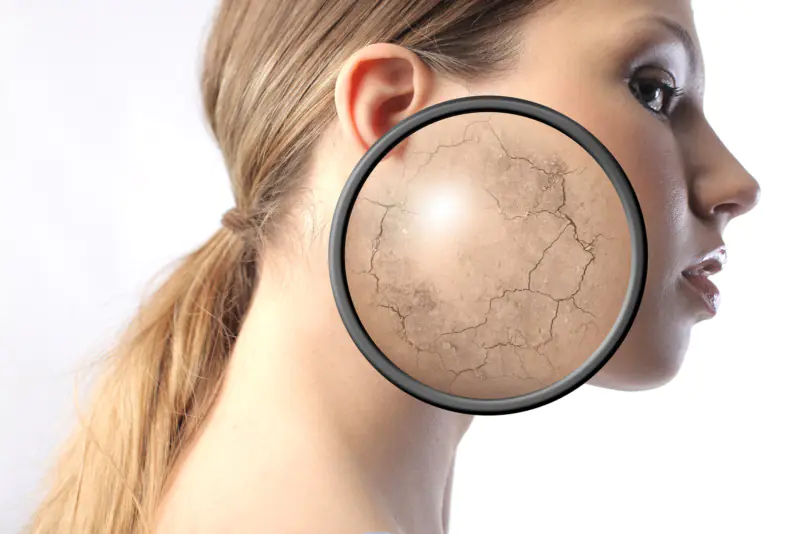
- If used continuously, it may disrupt the natural balance of the skin.
- Causes photosensitivity (photosensitivity).
- In some cases, it may cause an allergic reaction.
Chlorhexidine bigluconate is an inexpensive, safe and effective medicine that can be used against acne using different methods. It helps perfectly with small and medium-sized inflammatory processes. It is convenient to use this simple remedy for treating individual ulcers of various natures, as well as as part of therapeutic masks for a general tendency to rashes. However, if acne is severe and severe, you should consult a dermatologist. In such cases, complex treatment is prescribed.
Is it possible, and most importantly, is it necessary to use chlorhexidine for acne on the face? How effective is this wiping? This substance is a local antiseptic that eliminates the infection, but does not fight the cause of acne, so it can be used as an adjuvant.
The local antiseptic is effective against many bacteria, viruses and fungi, even those resistant to antibiotics (it itself does not belong to this group of drugs). It is used for external use for various lesions of the skin and mucous membranes. The product has an antibacterial effect, but does not dry the skin and practically does not cause allergic reactions.
The instructions provide for this drug only for external use - wiping the dermis, rinsing the mouth and throat. If ingested, irritation of the gastric mucosa and vomiting may occur. For this reason, it is not recommended for young children to use the product without adult supervision. There have been no cases of poisoning or overdose, either with proper use or with oral administration.
Chlorhexidine is a fairly effective remedy for acne. Since one of the links in the pathogenesis of acne is inflammation of clogged ducts of the sebaceous glands, a local antiseptic will be useful. It eliminates pathogenic microflora from the epidermis, thus helping to reduce the intensity of the inflammatory process, preventing its development and the penetration of bacteria into the affected area.
To achieve maximum effect, you need to wipe your face with chlorhexidine for acne 3-4 times a day.
It can also be used to prevent inflammatory diseases of the facial skin in cases where proper care and personal hygiene are difficult. For example, on a long trip, in nature, when it is not possible to use the entire range of care products, and the skin is prone to inflammation.
It is advisable to use the solution as part of a complex treatment. In order to completely eliminate acne, it is necessary to combine proper nutrition and a healthy lifestyle that maintains a normal supply of nutrients to the body, treatment of diseases of the digestive and endocrine systems, if any, proper skin care, sufficient hydration of the epidermis and wiping the face with local antiseptics.
Whether chlorhexidine helps with acne depends largely on how it is used. There are several simple rules on how to use it to get the desired result:
- Before wiping your face, you need to wash your hands and wash your face.
- After using chlorhexidine bigluconate for acne, you do not need to wipe it off, the product will dry on its own.
- After the product has dried, you need to apply a moisturizer.
Chlorhexidine against acne is much more effective if you use special cleansers against acne and blackheads, deep cleansing scrubs, moisturizing and nourishing creams that will help regulate the functioning of the sebaceous glands. A qualified dermatologist will help you choose the right regimen for caring for your epidermis. But if acne is severe, you will need the help of several specialists and a detailed diagnosis of the causes of skin diseases.
Side effects when using the drug are quite rare. In some cases, hypersensitivity to the active substance is observed. The question of whether it is possible to wipe the face with chlorhexidine for acne if local irritation is observed should be decided by a doctor.
Itching and burning of the skin is possible when applying the drug, which disappear on their own within a few seconds without any additional measures. This is caused by a slight irritant effect of the active substance on damaged skin. Most often, such phenomena only cause discomfort, but do not have serious consequences.
Chlorhexidine against acne cannot be used for severe inflammatory diseases of the dermis - its effectiveness will not be enough for treatment; antibiotics are required. Also, you should not resort to this remedy in case of serious injuries to the face and head for the same reason.
If the use of the drug does not have a significant beneficial effect, you should consult a doctor and select a comprehensive treatment regimen. It is even more worth doing this if the condition of the patient’s dermis worsens, foci of inflammation appear, and scars remain after acne.
The drug to combat acne can be purchased at pharmacies, as well as in hygiene departments; a prescription is not required to purchase it. The shelf life is 2 years when the package is closed; an opened bottle is good for about a month. After the expiration date, the drug is no longer suitable for use and its effectiveness is significantly reduced. It is recommended to store at room temperature, away from children and pets.
Anastasia, 16 years old, Omsk
I have problems with my skin, my mother says it’s hormonal and will go away in two years. She advised me to wipe my face with chlorhexidine to reduce breakouts. My acne has really decreased and my face has become clearer. But what really helped was that I started watching my diet, and now I look like a girl.
Evgeniya, 25 years old, Kemerovo
I haven’t thought about acne for a long time. And then suddenly they started to break out a long time ago when they were no longer in their teens. It turned out to be a hormonal imbalance, and I was prescribed a long course of treatment. I take hormonal pills, immunostimulating agents, and vitamins. I'm learning how to properly care for my face. To prevent acne from becoming inflamed, the dermatologist advised wiping it in the mornings and evenings with chlorhexidine. Within a month, a noticeable result is almost completely healthy skin, but it reacts very sensitively when I eat something wrong.
Kirill, 24 years old, Tyumen
I thought long and hard before writing this review. Still, I’m not a girl to talk about such things. But it turned out that my skin is ugly, there are always some kind of rashes, spots, or whatever these things are called. In general, I made an appointment with a dermatologist, he prescribed me a lot of things, including chlorhexidine. It helps, but slowly.
Ekaterina, 34 years old, Omsk
I dealt with acne on my face quite quickly with the help of chlorhexidine and a healthy diet. I had to wipe my face every day, 3-4 times, but as a result, the acne completely disappeared, no new ones appeared, and after a week I already looked much better. Now I haven’t had any problems with my skin for six months, although I don’t use any special products, I just wash my face regularly.
What is more effective - using chlorhexidine for acne on the face, or using some other local antiseptic? If we analyze the antibacterial and anti-inflammatory effect, it turns out that miramistin has approximately the same effectiveness. Both products are interchangeable and can be alternated for greater effectiveness.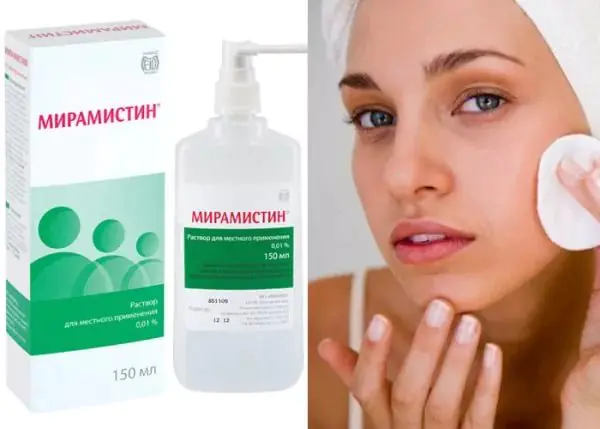
Using hydrogen peroxide and alcohol-based products is less effective. They exhibit the same antibacterial effect, but dry the skin, which provokes increased work of the sebaceous glands, more frequent blockage of their ducts and the appearance of new acne.
A local antiseptic becomes truly effective as part of a complex of facial skin care measures - gentle washing, deep cleansing, moisturizing and nourishing, regulating the functioning of the sebaceous glands, and only then - preventing the growth of microflora. If acne on the face is a consequence of any disease of the endocrine, digestive or immune system, then treatment of the underlying disease is required.
Using chlorhexidine for acne is quite effective in preventing inflammation and preventing infection from spreading to healthy areas of the skin. It is advisable to use this remedy as part of a set of measures for the treatment of acne and as prescribed by a doctor.
Chlorhexidine (chlorhexidine bigluconate) is an antiseptic for external use with antimicrobial activity. Doctors rarely prescribe chlorhexidine for acne on the face, mainly as an adjuvant. The drug is widely used in urology, gynecology, dentistry, and veterinary medicine. It is used to disinfect medical instruments, the surgical field and the surgeon’s hands, and to prevent sexually transmitted diseases. They treat wounds, gargle and mouth. But does chlorhexidine help get rid of acne?
Forms of release and principle of operation
Chlorhexidine bigluconate is available in different forms:
- aqueous solution with a concentration of the active substance of 0.05 and 0.2%;
- aqueous concentrate 20% (Dezin)
- alcohol solution 0.1% and 0.5% (Desiscrub);
- alcohol spray 0.5%;
- gel 0.5%;
- vaginal suppositories;
- bactericidal patch.



